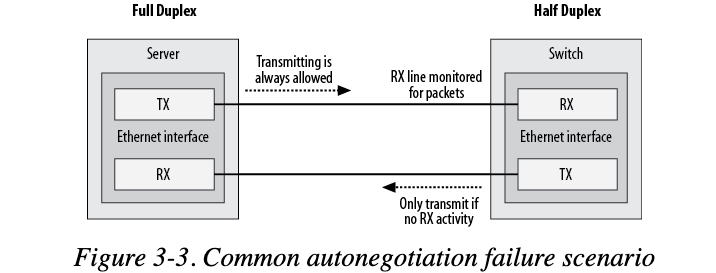Autonegotation
Feature that allows Network Switch or Router to communicate with other device to consider the Transmission Mode for the connection.
How it works
Autonegotation works as a protocol, it works if both devices enable autonegotation protocol.
The protocol will automatically find the best Transmission Mode and speed according to the highest that's available.
For example:
- If device A has tranmission mode
10/100/1000but only1000 Mbpsis full-duplex. Whereas device B has 10/100/1000 and they're all support full-duplex. Autonegotation process will choose1000 Mbps / Full duplex
When would autonegotiation fail
Autonegotation often fail if the the other device does not turn on Autonegotation. Or there is a autonegotiation conflict.
Autonegotation conflict happens when device is setting in different duplex mode (e.g 100/Full duplex vs 100/Half duplex
- This is because for half-duplex,
TXneeds to wait forRXto finish before can transmit - However if the other device is full-duplex, it will not monitor
RXand keeps sendingTX. Therefore the half-duplex will never reply
[!important]
Because of this, make sure they're configured the same way
What happen after autonegotiation fail
After autonegiation fail, a process called Parallel Detection will run in order to find the best speed (not the transmission mode). And then you need to set the duplex mode manually
Configuring autonegotiation on Cisco
- You need to config the speed first by
speed ? - Once you setting the speed, you can set duplex mode to
auto, full or half:duplex ?